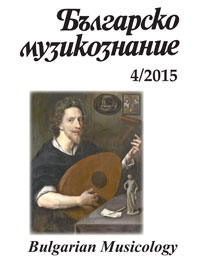„Когнитивни подходи към музикалния слух и музикалната памет”
Angelina Petrova: Cognitive Approaches to Ear for Music and Musical Memory
Author(s): Andrey DiamandievSubject(s): History, Theatre, Dance, Performing Arts, Fine Arts / Performing Arts, Cultural history, Music, Essay|Book Review |Scientific Life, Review, General Reference Works, Book-Review
Published by: Институт за изследване на изкуствата, Българска академия на науките
Summary/Abstract: Angelina Petrova’s book corresponds to the most up-to-date and topical studies on solfeggio worldwide, without breaking the relation with the traditional teaching practices in Bulgaria. The categories of musical understanding, hearing, aural training, consciousness, the latest scientific approaches used in the creation of the so-called neural network structures and neural maps, the terminological and structural study of musical memory, of the so-called ‘auditions’, as well as ‘F0 listeners’ or ‘spectral listeners’ present solfeggio in a completely different light, keeping nonetheless its substance in the strict music educational practices. In Chapter 1, Philosophic and Musical Hermeneutics and Ear for Music the author comments on the postmodern philosophy and its interpretations of musical hearing, drawing on the modern and postmodern theories of Theodor Adorno, Hans-Georg Gadamer, and later also of Gille Deleuze and Félix Guattari, making the important distinction in German language between ear for music and musical hearing, which in the Russian and Bulgarian traditions are fused into the former term, ear for music. In Chapter 2, Ear for Music in the Light of Contemporary Cognitive Psychology solfeggio is studied through cognitive psychology, shaping of musical perception and of musical notions in accordance with the cognitive and neuropsychological studies. Chapter 3 deals with musical memory, broaching the paramount views of cognitive psychology of musical memory: its definition, types, assumptions about its dynamic structure, the issues of the long-term musical memory and the correlation between it and melodic dictation. Chapter 4, Tonal Syntax and Ear for Music interprets melodic dictation, basic theoretical notions in music aural analysis, an analytical aural method in dictation are considered, with the study focusing here on its practical part: 1-, 2-, 3- and 4-part dictation. The section dealing the specifics of the dictations by ‘parameters’ in some systems of West-European methods is especially valuable. Chapter 5 explores the models of the post-tonal ear for music and melodic dictation in post-tonal music. The chosen thematic line evinces the author’s innovative methodology drawing on various modern views and models, e.g. Pierre Boulez, Utz and Kleinrath, including also postmodern composers in the process of solfeggio training such as Stockhausen, Ligeti, Lachenmann, Ferneyhough.
Journal: Българско музикознание
- Issue Year: 2015
- Issue No: 4
- Page Range: 111-117
- Page Count: 7
- Language: Bulgarian
- Content File-PDF

